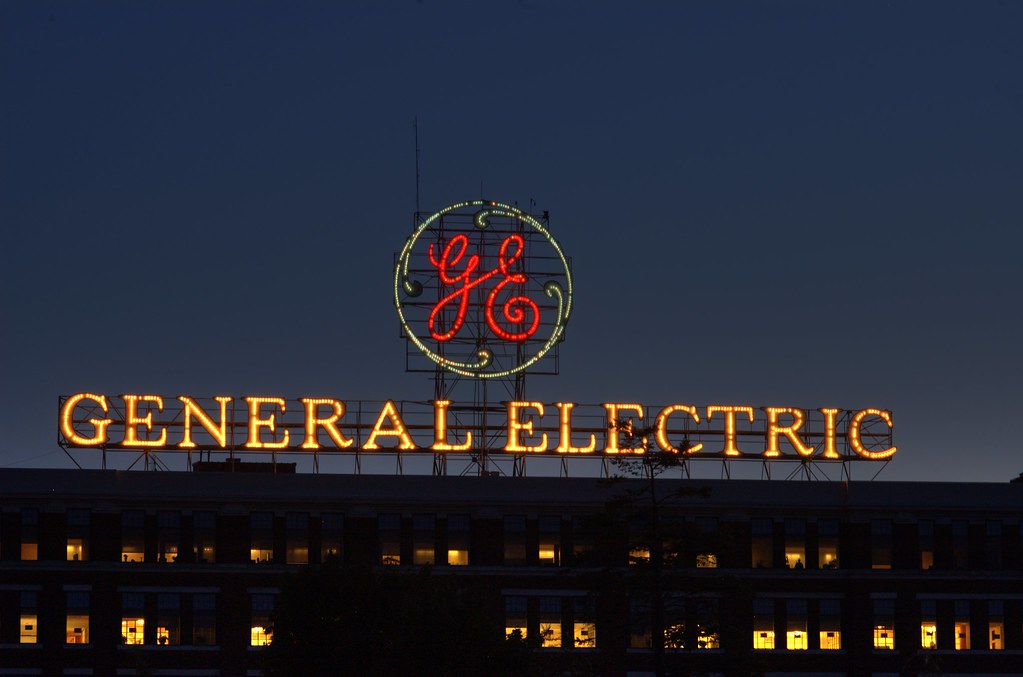
General Electric began in 1892 when several companies merged together, including Thomas Edison’s Lamp Company. The men in charge hoped for lasting success. But it’s unlikely they expected their company would remain one of the largest in the world for over 100 years.
In 2000, GE was the most profitable company in the world. Yet two decades later, profits have nosedived, as has the value of the company. Why?
The answer is complex. Read on for some history and explanation.
History of General Electric: The Foundations
GE sprung from the merging of a lamp manufacturer, an electric company, and a railway & motor company. When the Dow Jones Industrial Average was first published in 1896, GE was one of the first companies listed. The company helped industrialize America through the availability of cheap electricity.
Some of this cheap electricity came from water wheel generators and turbines GE sold to different power companies. This includes three 25-cycle 3-phase water wheel generators located at Niagara Falls. Additionally GE turbine generators were used in the Grand Coulee Dam, which opened in 1942.
Further, this same cheap electricity brought lamps(and light bulbs), washing machines, radios, electric fans, and other electrical devices into the everyday household. GE was the first to mass-produce these appliances, changing the way the American household ran forever.

GE: The War Years
Many companies had to innovate during World War II. But GE rose to the test.
Many of the USA’s radar systems used GE magnetron tubes. The glass-encased tubes, invented a decade earlier, let the company make significant improvements in both radio and X-ray technology. After WWII ended, this same technology led to the development of the microwave oven.
As World War II waned, GE continued working on its jet engine technology. Their first engine, the GE 1-A, came too late. But only a few years later, GE introduced the J-47 jet engine. This engine would become one of the most popular in history.

Jack Welch and Expansion
In 1981, John (Jack) Welch Jr. became the chairman and CEO of General Electric. A former chemical engineer, Jack built GE up from a middling company into a dynamo. He was the most well-known businessman of his era and a sought-after speaker and consultant.
During Welch’s time as CEO, GE transformed from a $12 billion manufacturing company into a $410 billion giant. During that 20 years, GE had acquired NBC, RCA, and nearly 600 other additions. The company changed management styles and adopted Six Sigma programs for their manufacturing facilities.
However, Welch left GE just as rising technology stocks changed the playing field. Many have blamed Welch’s extreme expansion of the previous decade for GE’s following problems.
General Electric: Crisis Years
From 2001 until now, GE has suffered consecutive blows. This includes
- The 2001 tech bubble (explained above).
- The 2008 financial crisis. Multiple banking problems (too much risk-taking, predatory mortgage lending, collapse of the US housing bubble) caused a global financial and banking crisis. GE stock fell 42% in one year. The company sold off several major subsidiaries, including GE Plastics, GE Applliances, and NBC Universal.
- The 2017 125th Company anniversary and restructuring. In 2017, GE celebrated its 125th year in business. Things seemed like they were better. However, in November of that year, the company announced they were going to restructure. The company shed 12,000 jobs. Stocks dropped again.
- COVID-19 Pandemic. Like most other businesses, GE has been adversely affected by the worldwide pandemic. Their aviation unit was especially hard hit as air companies around the globe grounded their planes due to a lack of passengers. Without demand, companies dropped orders for planes and plane parts. GE furloughed many employees. These “lack of work” periods lasted months.
General Electric: The Future Focus
However, General Electric hasn’t thrown in the towel. Not even close. Despite pandemic woes, over the last three years GE has slowly gained strength and improved their management. Their future plans seem to be focused on four divisions, including:
GE Aviation
The pandemic cut GE Aviation’s profitability, but now they’re on the rebound. The company has invested in new sustainable technologies to reduce jet fuel consumption. They’ve also focused on new technology like additive manufacturing, using 3D printing technology to print parts for engines.
Meanwhile, GE continues to partner with the US military on projects like its Adaptive Cycle Engine. This propulsion technology engine delivers efficiency or power on demand. GE also provides efficient marine gas turbines to the US Navy to power everything from patrol boats to destroyers to amphibious ships and aircraft carriers.
GE Healthcare
Unlike aviation, healthcare profits improved during the pandemic. A recent (Aug 2021) agreement between General Electric and Amazon Web Services should cement this profitability. The two companies plan to work together to offer cloud-based imaging solutions and AI-based integrated data insights to healthcare providers.
This type of healthcare model is an extension of virtual care options that became popular during the pandemic. This pairing will help radiologists access data more efficiently from anywhere, and give them the tools to make diagnoses from anywhere.
GE Power
GE’s history in the power industry stretches back over a century. The company has deep roots in the creation of gas and steam turbines for power production and industrial control.
GE turbine systems show up everywhere power is created. You will find them in nuclear power plants, in hydro-electric plants, in vessel control and automation, as well as in coal-to-gas transition plants and combined cycle plants.
Moving into clean energy, GE has also researched and worked on power production using micro hydro systems and tidal energy.
GE Renewable Energy
A few years ago, some considered GE Renewables was an anchor. But then 2020 revenues were $1 Billion more than 2019’s. GE’s Haliade-X wind turbines are part of this success. Orsted US Offshore Wind’s one US wind farm, located off the New Jersey shore, uses the Haliade-X, which is the world’s most powerful offshore wind turbine. It is slated for use in future US and UK projects developing now.
GE is investing heavily in renewables, recently announcing they would purchase Denmark-based LM Wind Power. LM Wind supplies blades to GE wind, and has thirteen factories located on four different continents.
GE also shows up in solar energy systems. Solar power often needs storage. GE has invested research in battery energy storage solutions and balance of plant equipment.
AX Control can help you with sourcing GE Boards and Turbine Control. Talk to our team today!
AX Control sells other GE parts and components, too. Let us know how we can help.

You must be logged in to post a comment.